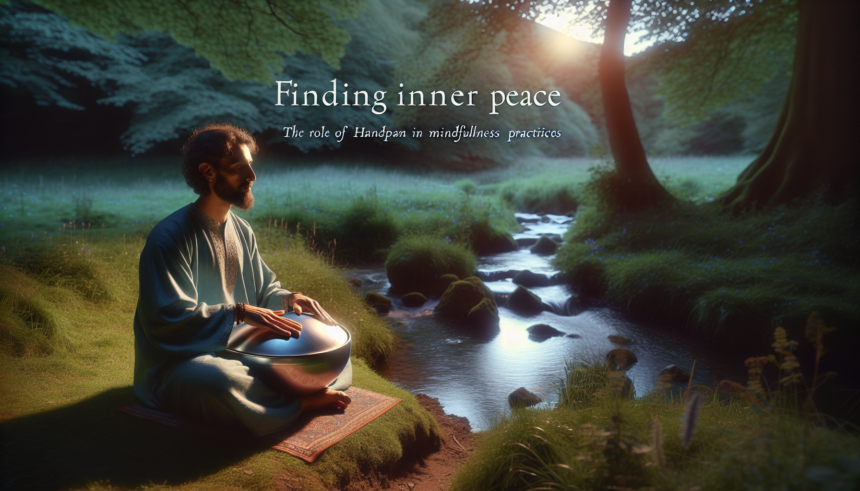In a world that is increasingly becoming fast-paced and chaotic, the quest for inner peace has become more pertinent than ever before. Mindfulness practices have grown in popularity as effective strategies for achieving mental clarity, emotional balance, and an overall sense of serenity. Among the diverse tools used in mindfulness practices, the handpan stands out as an especially unique and powerful instrument.
The Emergence of Handpan
The handpan is a relatively recent invention, having first been created in the early 2000s. Originating from Switzerland, this steel percussion instrument is shaped like a UFO. Its surface contains several indentations, each tuned to a different note. The handpan’s ethereal and harmonious sounds have quickly captured the interest of musicians and meditators worldwide.
The handpan is praised for its capability to produce soothing, resonant tones that naturally facilitate relaxation and introspection. When played, it creates soundscapes that can easily transport listeners into a meditative state. This makes it an ideal companion for mindfulness practices.
Understanding Mindfulness
Mindfulness is the practice of being fully present and engaged in the current moment, with a non-judgmental awareness of one’s thoughts, feelings, and surroundings. It involves cultivating an open, curious, and accepting attitude toward whatever arises in the present moment. Various techniques, such as meditation, breathing exercises, and mindful movement, are employed to develop and deepen this state of awareness.
Research has shown that mindfulness can enhance psychological well-being, reduce stress, and improve emotional regulation. By fostering a sense of inner calm and clarity, mindfulness helps individuals navigate the challenges of daily life with greater ease and resilience.
The Role of Music in Mindfulness
Music has always held a special place in human culture, serving as a means of expression, connection, and emotional regulation. In the context of mindfulness, music can play a crucial role in supporting and enhancing the practice. Here are some ways in which music can contribute to mindfulness:
- Promoting Relaxation: Calming music can help soothe the nervous system, reduce stress, and promote a sense of tranquility.
- Focusing Attention: Musical rhythms and melodies can serve as anchors for concentration, making it easier to maintain focus during meditation or mindful activities.
- Evoking Emotions: Music has the power to evoke a wide range of emotions, helping individuals explore and process their inner experiences in a mindful way.
- Creating a Mindful Environment: A carefully curated musical backdrop can enhance the overall ambiance of mindfulness sessions, making them more immersive and enjoyable.
The Handpan’s Contribution to Mindfulness
The handpan stands out among musical instruments for its unique ability to seamlessly integrate into mindfulness practices. Here are some specific contributions of the handpan:
1. Aiding Deep Meditation
The handpan’s calming and otherworldly sounds are highly conducive to deep meditation. The gentle resonance and harmonics of the instrument create a sense of spaciousness, allowing meditators to sink into a state of profound stillness and tranquility. This makes it an excellent tool for both novice and experienced meditators.
2. Enhancing Breath Awareness
Breath awareness is a fundamental aspect of mindfulness. The rhythmic patterns produced by the handpan can mirror the natural rhythm of the breath, helping individuals synchronize their breathing with the music. This harmonious relationship between breath and sound can deepen the meditative experience and foster a greater sense of connectedness with the present moment.
3. Facilitating Emotional Release
Emotional release is an integral part of mindfulness, as it involves acknowledging and processing emotions in a healthy way. The handpan’s evocative melodies have the capacity to touch the depths of the heart, evoking a wide range of emotions. This can provide a safe and supportive space for individuals to explore and release suppressed feelings, leading to emotional healing and balance.
4. Supporting Group Mindfulness Sessions
The handpan is not only beneficial for individual practice but also for group mindfulness sessions. Its enchanting sounds can create a sense of unity and coherence among participants, fostering a shared experience of presence and connection. Whether used in group meditations, yoga classes, or sound baths, the handpan’s music can enhance the collective energy and deepen the overall experience.
5. Encouraging Mindful Movement
Mindful movement practices, such as yoga, tai chi, and qigong, emphasize the integration of body and mind. The fluid and rhythmic nature of handpan music can serve as an excellent accompaniment to these practices, guiding and inspiring graceful and mindful movement. The music’s gentle flow can help individuals attune to their body’s sensations and cultivate a sense of harmony in their movements.
Incorporating Handpan into Your Mindfulness Practice
Integrating the handpan into your mindfulness practice can be done in various ways. Here are some practical tips for incorporating this beautiful instrument:
1. Create a Sacred Space
Designate a serene and clutter-free space for your mindfulness practice. Set up your handpan in this space, along with any other mindfulness tools you use, such as cushions, candles, or incense. Creating a dedicated environment can enhance the sacredness and intentionality of your practice.
2. Begin with Breath Awareness
Sit comfortably with your handpan in front of you. Close your eyes and take a few deep breaths, allowing yourself to settle into the present moment. As you begin to play the handpan, synchronize your breath with the music. Let the sound and rhythm guide your breathing, fostering a sense of relaxation and presence.
3. Use Intention and Imagination
Set an intention for your mindfulness practice. This could be cultivating inner peace, exploring emotions, or simply being present. As you play the handpan, visualize the sound waves spreading positive energy and creating a healing space around you. Use your imagination to enhance the depth and impact of your practice.
4. Explore Sound Meditation
Sit or lie down in a comfortable position, close your eyes, and focus on the sounds of the handpan. Allow the music to guide your attention and gently bring your mind back whenever it starts to wander. Embrace the ebb and flow of the music, letting it deepen your state of meditation and introspection.
5. Experiment with Movement
If you practice mindful movement, such as yoga or tai chi, try incorporating the handpan as a musical accompaniment. Allow the music to inspire and guide your movements, aligning your body and mind with the rhythm and flow of the sound. This can enhance the overall experience and create a harmonious integration of movement and mindfulness.
Conclusion
The handpan is a remarkable instrument that holds immense potential for enriching mindfulness practices. Its soothing sounds, harmonious resonance, and evocative melodies make it a powerful tool for deepening meditation, enhancing breath awareness, facilitating emotional release, and supporting both individual and group mindfulness sessions. By incorporating the handpan into your mindfulness practice, you can embark on a journey of inner peace and self-discovery, finding solace and serenity in the midst of life’s challenges.
Frequently Asked Questions (FAQs)
1. What is a handpan?
A handpan is a steel percussion instrument characterized by its unique UFO-like shape and resonant, soothing sounds. It features several indentations, each tuned to a different note, and produces harmonious melodies that are ideal for mindfulness practices.
2. How does the handpan contribute to mindfulness?
The handpan’s calming and enchanting sounds can aid meditation, enhance breath awareness, facilitate emotional release, support group mindfulness sessions, and encourage mindful movement. These qualities make it an ideal instrument for enriching mindfulness practices.
3. Can beginners use the handpan for mindfulness practices?
Absolutely! The handpan’s intuitive layout and soothing sounds make it accessible to beginners. Its calming effects can provide a gentle introduction to mindfulness, helping newcomers establish a sense of presence and relaxation.
4. Do I need musical experience to play the handpan?
No prior musical experience is required to play the handpan. Its design allows for intuitive and expressive playing, making it accessible to individuals of all musical backgrounds. The focus is on creating and experiencing sound rather than achieving technical proficiency.
5. Where can I find a handpan?
Handpans can be purchased from specialized instrument makers and retailers, both online and in physical stores. It’s important to choose a reputable source to ensure the quality and authenticity of the instrument. Additionally, attending handpan workshops or festivals can provide opportunities to learn more and try out different handpans before making a purchase.





